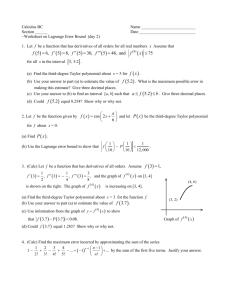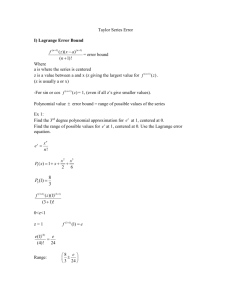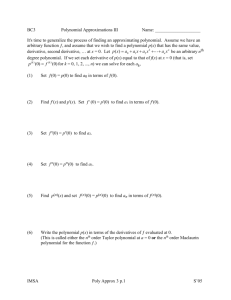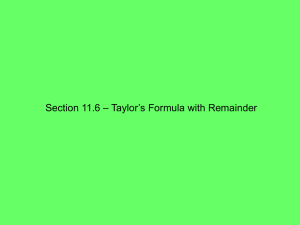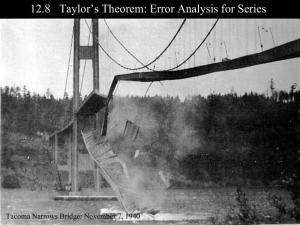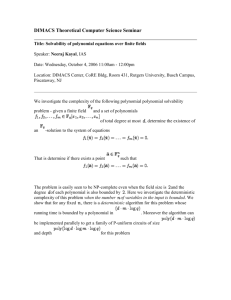Taylor Error: Actual, La Grange and Alternating Series
advertisement
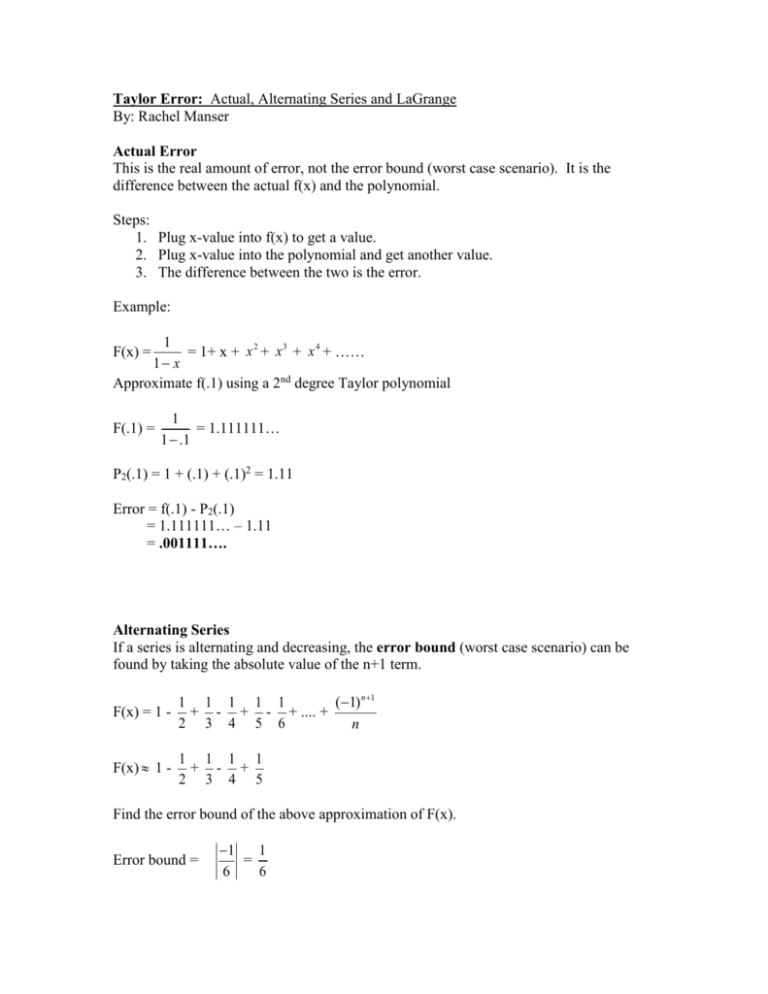
Taylor Error: Actual, Alternating Series and LaGrange By: Rachel Manser Actual Error This is the real amount of error, not the error bound (worst case scenario). It is the difference between the actual f(x) and the polynomial. Steps: 1. Plug x-value into f(x) to get a value. 2. Plug x-value into the polynomial and get another value. 3. The difference between the two is the error. Example: 1 = 1+ x + x 2 + x 3 + x 4 + …… 1 x Approximate f(.1) using a 2nd degree Taylor polynomial F(x) = F(.1) = 1 = 1.111111… 1 .1 P2(.1) = 1 + (.1) + (.1)2 = 1.11 Error = f(.1) - P2(.1) = 1.111111… – 1.11 = .001111…. Alternating Series If a series is alternating and decreasing, the error bound (worst case scenario) can be found by taking the absolute value of the n+1 term. F(x) = 1 - 1 1 1 1 1 (1) n 1 + - + - + .... + 2 3 4 5 6 n F(x) 1 - 1 1 1 1 + - + 2 3 4 5 Find the error bound of the above approximation of F(x). Error bound = 1 1 = 6 6 La Grange This method uses a special form of the Taylor formula to find the error bound of a polynomial approximation of a Taylor series. The La Grange Formula: Error bound = f n1 ( z )( x a)n1 (n 1)! The variable z is a number between x and a, but to find the error bound, z ends up being equal to one of the two. To determine whether the z value will be the same as x or a, you must plug each number into f n 1 ( z ) to see which gives the greatest number. For example: If you are trying to find the error of a 2nd degree Taylor polynomial 1 approximation of f(x) = , you must first find the 3rd derivative, because the formula 1 x uses f n 1 ( z ) , not f n ( z ) . 1 2 6 f’(x) = , f’’(x) = , and f’’’(x) = 2 3 (1 x) (1 x) (1 x) 4 Also, for this function, x = .1 and a = 0. Plug these two values into the 3rd derivative. f 3 (0) 6 =6 (1 0) 4 f 3 (.1) 6 = 9.145 (1 .1) 4 this is bigger! Next, plug in 9.145 for f n 1 ( z ) in the La Grange formula: Error bound = 9.145(.1 0)3 = .00152 3! Exception! When f(x) = sin(x) or cos(x), the value for f n 1 ( z ) will always be equal to 1, because that is the greatest value of any sin or cos function. Examples for La Grange error bound: a.) Find the upper bound for the error for the 5th degree polynomial approximation of e. e is equal to e1 , whose series can be determined from the Taylor series of e x . 0 e1 (1) (1)1 (1) 2 (1)3 (1)4 (1)5 0! 1! 2! 3! 4! 5! The La Grange formula is, f (6) ( z )( x)6 6! All derivatives of e1 are e1 ,so f 6 ( z ) = e z To find z, plug in the values for a and x into e z . a= 0 , e0 1 x=1 , e1 e e 1 , so z 1 e e e1 (1) 6 .00377 = 6! 720 6! The actual error for this 5th degree polynomial falls somewhere between the real value of e1 and e1 + .00377. e1 = 2.71828 e1 1 1 1 1 1 1 2.71666 2! 3! 4! 5! The error is 2.71828 – 2.71666, which equals 0.00162. This number is less than the upper bound for the error, 0.00377, which shows how the La Grange formula works. b.) What degree Taylor polynomial for ln(1.2) might have an error less than 0.001? (In other words, the upper bound for the error would be 0.001) First, start off with the La Grange formula, whose value must be less than 0.001: f n1 ( z )( x a)n1 < 0.001 (n 1)! For the function ln(x), a =1 and in this case, x =1.2 The derivatives of ln(x) are as follows: f ( x) ln( x), f '( x) 1 1 2 6 , f ''( x) 2 , f '''( x) 3 , f ''''( x) 4 x x x x Since you don’t know the value of n, a general formula for the n 1 derivative must be used. The formula for the nth derivative can be obtained from above and is as follows: (1) n 1 (n 1)! To find f n 1 ( x) , simply substitute n 1 for n into f n ( x) n x that equation: (1) n 2 (n)! f n 1 ( x) x n 1 This is what you will put into the La Grange formula for f n 1 ( z ) , changing x to z. Still, you must find the value for z. It will be equal to either a or x. When plugging the two values into the above list of derivative for ln(x), you find that 1 always produces the greater value, so z = 1. Now, the error bound formula looks something like this: (1)n 2 (n)! (n)! n 1 ( x a)n 1 (1.2 1) n 1 n 1 n 1 n ! (.2) n 1 1 .2 z z 0.001 (n 1)! z n 1 n 1 z (n 1)! (n 1)! 1 n 1 .2 0.001 n 1 Next you must simply use the concept of trial and error. Choose values for n and keep plugging them in to the inequality. When the term on the left ends up being greater than 0.001, you know that you have crossed the line and your value for n will be the previous number (before the value exceeded 0.001). 1 31 .2 .0004 .001 3 1 The value for n is 3. 1 2 1 .2 .00267 .001 2 1
